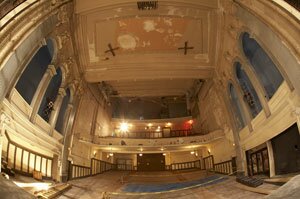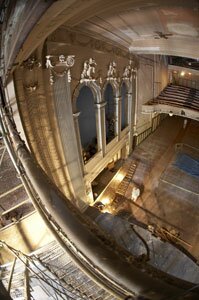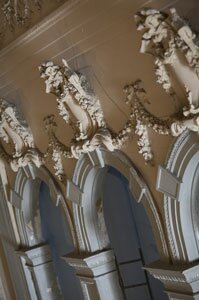ONARCHITECTURE- Star reborn: Jefferson readied for next act
When Hook editor Hawes Spencer sold the Jefferson Theater to Coran Capshaw in April, he had mixed feelings. After all, he'd operated the Jefferson on a shoestring budget for 14 years as a second-run movie house and concert venue, rebuffed offers from developers who wanted to turn it into condos, and spent his spare time improving and tinkering with the old building. Owning "the Jeff" had been a labor of love as well as a sound investment. Would Capshaw care about the building as much as he had?
After a look at what Capshaw has done so far, those mixed feelings seem to have vanished.
"I was blown away to see it all together for the first time in one big, beautiful space," says Spencer.
Capshaw has removed the partition built in the 1980s to create the upstairs screening room, as well as a stage firewall and the wall blocking off "peanut gallery" seating near the roof, opening up all views to the main stage for the first time since World War II.
"There's lots of plaster damage," says Spencer, " but once it's properly repaired and painted, people are going to be stunned by its beauty."
Built in 1901 to house a bank, the building was sold to a theater company in 1912. The new owners remodeled the interior and built the theater that extends to Water Street. After most of the interior was destroyed in a 1915 fire, the theater was rebuilt under the supervision of C. K. Howell, the architect who also brought his interpretation of "Adamesque" classicism to the Empire and National theaters in Richmond.
In its early years, the Jefferson hosted vaudeville acts, silent films, and performers such as Harry Houdini and the Three Stooges. When silent films and "talkies" came to dominate the theater business, the opera boxes that provided limited views of the screen were sealed off. In 1969, a group of local businessmen bought the building and re-named it the Cinema Theater. By the late 1970s, it had acquired a reputation for showing so many x-rated films that it was nicknamed "the Skinema."
In 1983, owner Alton Martin sealed off the mezzanine to create the upstairs theater, renamed it the "Movie Palace," and began showing second-run films. Spencer bought the theater at auction in 1992 after Martin's death when his estate defaulted on a loan.
During a recent tour of the building with Ted Early, Capshaw's project manager, it was evident that under all the "improvements" made during the '70s and '80s– including velvety cartoonish wallpaper in the lobby– lies an architectural treasure.
"The whole process until now has been about demolishing the work done in the '70s and '80s, doing structural work, and finding out about the building," says Early. "We're in an investigative stage right now. Every day I learn something new in here."
For instance, although Early grew up in Charlottesville and remembers going with his father to the old pool hall in the basement of the building and taking dates to the movies as a teenager, he never knew the "peanut gallery" section of the theater existed.
Standing there now, Early says, "This upper balcony provides the best view of the stage."
Indeed, from that height, one has the sensation of soaring over the whole space. In addition, the elaborate classical plasterwork rising above the opera boxes, once hidden in the dark upper corners of the lower theater, is in full view now– as impressive, Early thinks, as any detail work in the Paramount.
Still, restoring the old building to its original grandeur is a daunting task, one that Early hopes to tackle in the months ahead. "We're just fixing what's broken right now," he says. "Then we'll begin to choose a wish list and a direction."
If wish lists come true, the Jefferson could be a spectacular new venue. Or, as Spencer puts it, "I think it's going to be the working man's Paramount."

Now showing: This view from the stage of the Jefferson, with the mezzanine and upper balcony above, hasn't been seen since World War II.
PHOTO BY MICK TAVISH

Set designs: The elaborate plasterwork rising up above the opera boxes, once hidden in the dark upper corners of the lower theater, is now in full view.
PHOTO BY MICK TAVISH

The elaborate classical plasterwork rising above the opera boxes, once hidden in the dark upper corners of the lower theater.
PHOTO BY MICK TAVISH
#